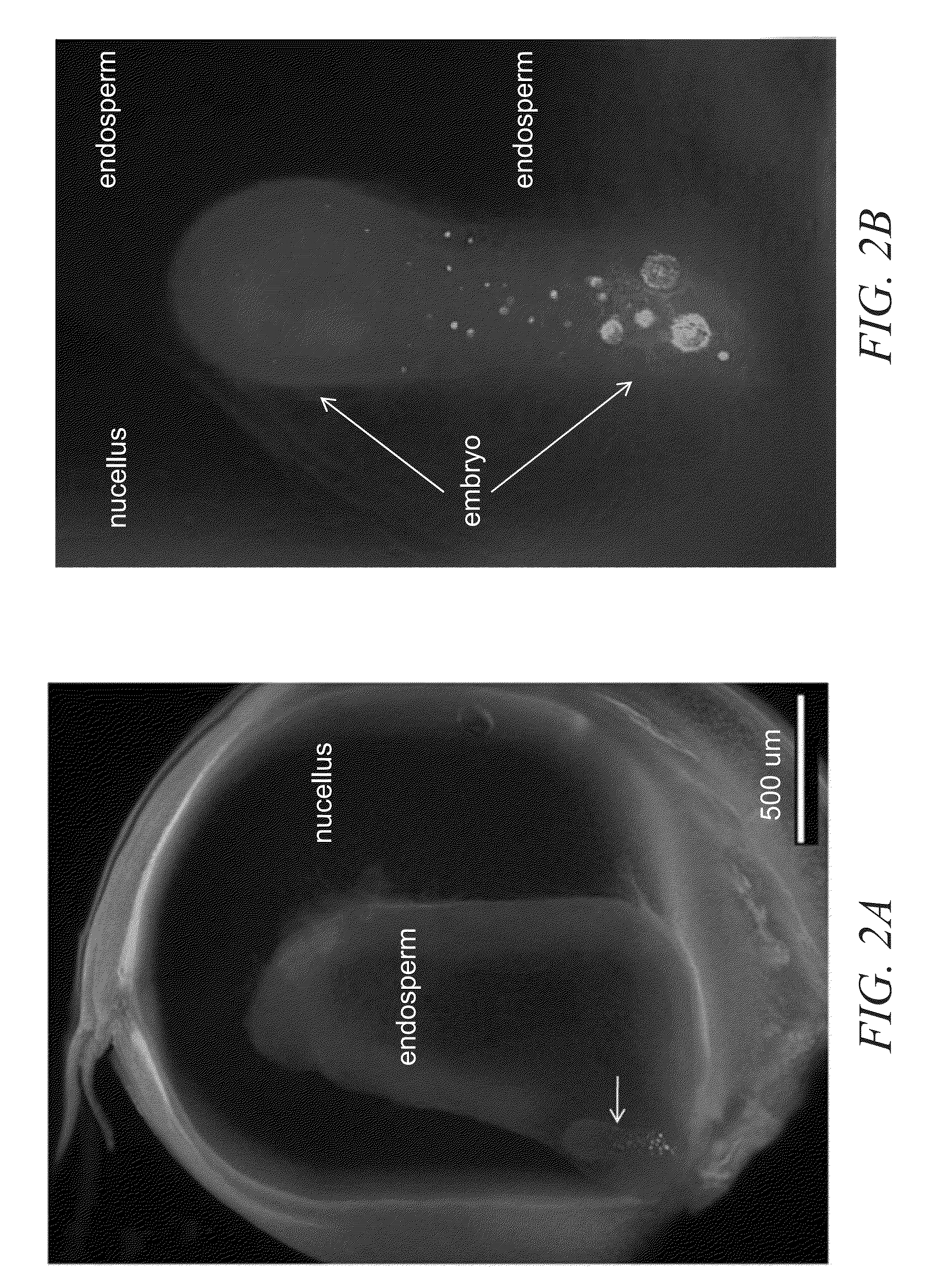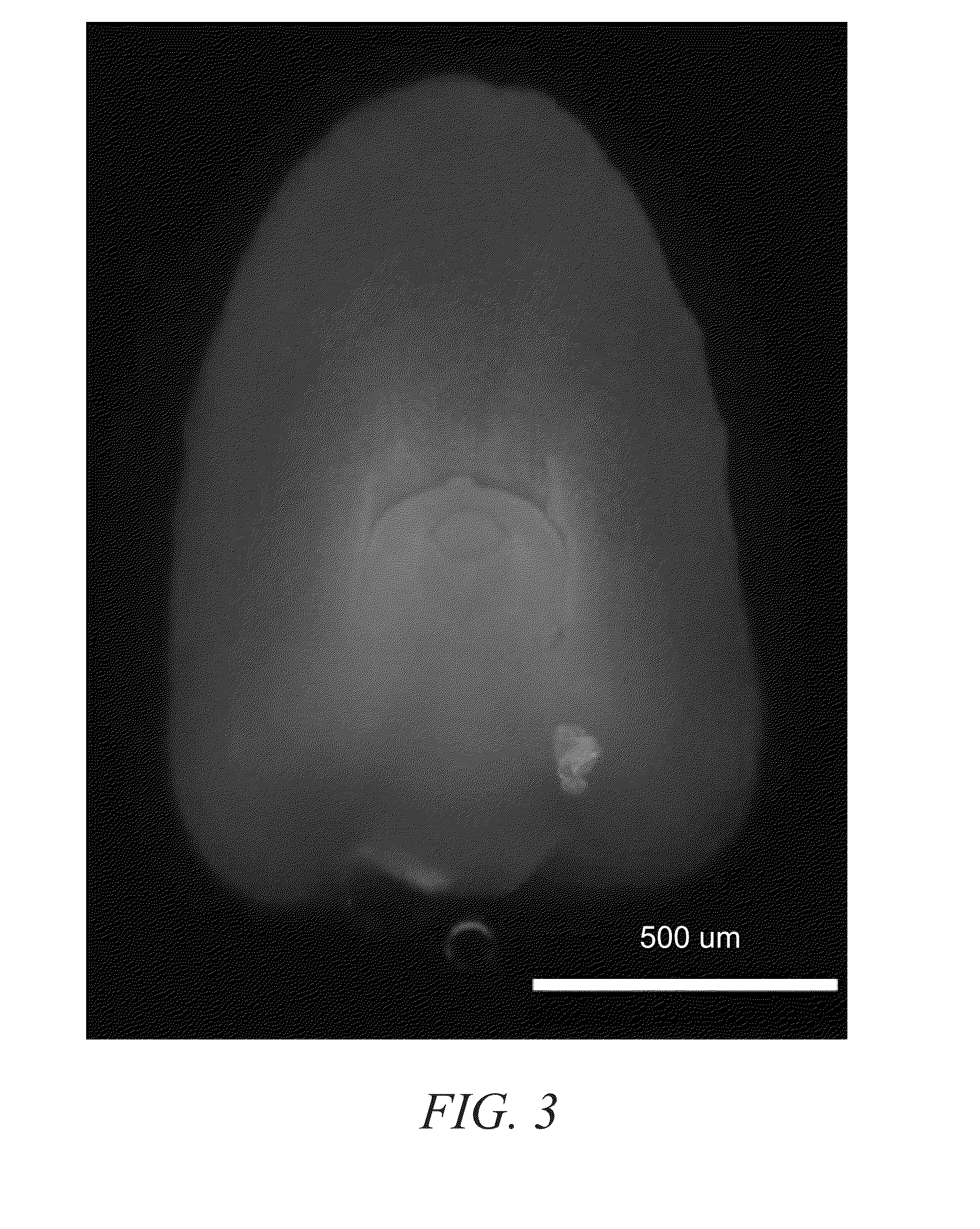Compositions and methods for the expression of a sequence in a reproductive tissue of a plant
a technology of plant tissue and sequence, applied in the field of plant molecular biology, can solve the problems of damage to target cells without harm, cytological or genetic means are available but have known limitations
- Summary
- Abstract
- Description
- Claims
- Application Information
AI Technical Summary
Benefits of technology
Problems solved by technology
Method used
Image
Examples
example 1
Identification of the ZM-DD45 Promoter
[0117]The Zm-DD45 gene was cloned from B73 genomic DNA by using PCR to amplify approximately 1.3 Kb upstream of the putative translational start using the PCR primer shown in SEQ ID NO: 35 and down through the putative promoter translational stop codon using primer shown as SEQ ID NO: 36. The PCR fragment was extracted from an agarose gel slice using Qiagen's QIAquick Gel Extraction Kit and cloned into Invitrogen's pCR2.1 TOPO Vector using manufacturer's instructions. This clone was used to subclone the ZM-DD45 promoter (SEQ ID NO: 34) into a transformation vector to drive the expression of the fluorescent reporter gene, ZS-GREEN1. This clone was designated PHP46361 and contained: ZM-DD45 PRO:ZS-GREEN1—UBIZM PRO:UBIZM 5′UTR:UBIZM INTRON:MO-PAT
[0118]A second construct containing the Arabidopsis DD45 promoter was designated PHP46360 and contained: AT-DD45 PRO:DS-RED EXPRESS—AT-DD31PRO:AC-GFP1—AT-DD65 PRO:AM-CYAN1. Approximately, ten single copy T0...
example 2
Microscopic Observation of Egg Cell-Specific Expression
[0119]Ears were kept on ice and individual kernels (unpollinated and 5DAP) were dissected from the ears and placed in PBS (pH7.2) on ice. Some kernels were fixed for long term storage, placed in 4% para-formaldehyde overnight at 4° C. then washes 3 times in PBS and stored at 4° C. Each kernel was then carefully sectioned, vertical or horizontal longitudinally, using an ophthalmic scalpel in order to obtain 100-300 μM thick slices with the intact embryo sac inside. These tissue slices were placed on glass slides in PBS and ready for microscopic observations.
[0120]Observations and images were taken with a Leica (Wetzlar, Germany) DMRXA epi-fluorescence microscope with a mercury light source. The Alexa 488 #MF-105 (exc. 486-500, dichroic 505LP, em. 510-530) fluorescent filter set was used to monitor ZsGreen fluorescence. Autofluorescence from the kernel tissues was also monitored using Cy3 #C-106250 (exc. 541-551, dichroic 560LP, e...
example 3
ZM-DD45 Promoter Expresses Preferentially in Egg Cells
[0121]Microscopic evaluations of unpollinated kernels from PHP46361 ears revealed ZsGreen fluorescence in the egg cells only (FIG. 1). ZsGreen fluorescence was also detected in young embryos after pollination. By the globular embryo stage of development, the ZsGreen fluorescence is reduced or diluted (FIG. 2) and at later stages of embryo development the fluorescence cannot be detected (FIG. 3). These observations suggest that the ZM-DD45 promoter expresses specifically in egg cells and in early embryo development. Microscopic evaluations of kernels from PHP46360 ears showed that the AT-DD45 promoter expressed very similarly as the maize DD45 promoter in maize kernels. DS-RED EXPRESS fluorescence was detected only in egg cells from unpollinated kernels (FIG. 4). This fluorescence is also seen in early embryo development (FIG. 5) but begins to wane at the globular and later stages of embryo development.
[0122]Both the Arabidopsis a...
PUM
| Property | Measurement | Unit |
|---|---|---|
| Tm | aaaaa | aaaaa |
| Tm | aaaaa | aaaaa |
| average diameter | aaaaa | aaaaa |
Abstract
Description
Claims
Application Information
 Login to View More
Login to View More - R&D
- Intellectual Property
- Life Sciences
- Materials
- Tech Scout
- Unparalleled Data Quality
- Higher Quality Content
- 60% Fewer Hallucinations
Browse by: Latest US Patents, China's latest patents, Technical Efficacy Thesaurus, Application Domain, Technology Topic, Popular Technical Reports.
© 2025 PatSnap. All rights reserved.Legal|Privacy policy|Modern Slavery Act Transparency Statement|Sitemap|About US| Contact US: help@patsnap.com



